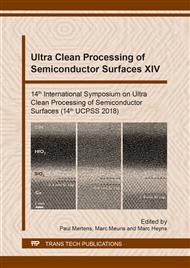p.43
p.48
p.52
p.59
p.64
p.73
p.77
p.83
p.88
Damage-Free Cleaning of Advanced Structure Using Timely Energized Bubble Oscillation Megasonic Technology
Abstract:
The use of highly corrosive chemicals to remove nano-particles on the surface of the wafer, results in substrate losses. This has resulted in the use of megasonics which provides acoustic cavitation to remove small particles. The megasonic wave does generate bubble cavitation which applies mechanical force to wafer structure, the violent cavitation such as transit cavitation or micro jet will damage the patterned structures [1,2]. A new megasonic technology is proposed in this paper, this technology provides stable control of bubble cavitation, without pattern damage at the different modes. The technology shows better particle performance when compared with the industry standard two-fluid nozzle cleaning technology. This Timely Energized Bubble Oscillation mode provides stable cavitation with a wide power window. It is unlike conventional megasonic which creates transit cavitation and damage when the bubble implodes. This new megasonic technology can be used to clean “sensitive” structures at 28nm and below without any pattern damage.
Info:
Periodical:
Pages:
64-72
Citation:
Online since:
August 2018
Price:
Сopyright:
© 2018 Trans Tech Publications Ltd. All Rights Reserved
Share:
Citation:


